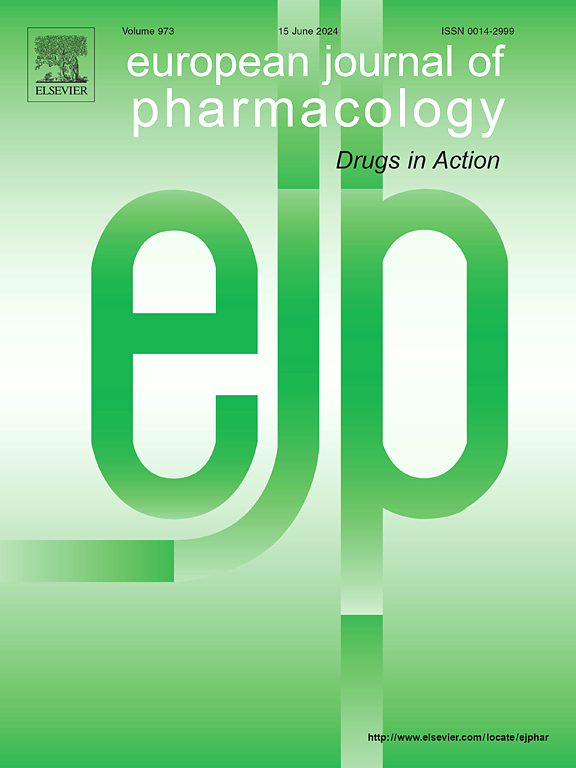新型σ1受体配体(S)-L1对缺血脑内皮细胞和脑血管反应性的影响。
IF 4.2
3区 医学
Q1 PHARMACOLOGY & PHARMACY
引用次数: 0
摘要
细胞内σ -1受体(σ -1 receptor)通过调节脂筏、神经受体和离子通道发挥多种功能,影响信号转导和神经元的可塑性。由于σ1受体活性降低是许多神经系统疾病早期的常见病理特征,因此σ1受体激动剂可能是治疗这些疾病的一种有前途的治疗工具。在本研究中,我们旨在全面研究新型合成的σ1受体激动剂(S)-L1对内皮内质网应激和脑缺血的潜在保护作用。在结合亲和力实验中,我们发现(S)-L1对σ1受体具有很高的亲和力和选择性,而对其他受体几乎没有亲和力。(S)-L1对人脑内皮细胞内质网应激具有保护作用,这与内皮细胞中σ1受体的定位一致。此外,在血脑屏障的细胞培养模型中证实了(S)-L1的渗透,这为除了内皮保护外,神经元的作用提供了理论依据。最后,在脑缺血大鼠模型中,(S)-L1抑制扩张性去极化,抑制细胞凋亡,挽救星形胶质细胞。根据我们的研究结果,(S)-L1对脑内皮细胞和神经组织都有保护作用。此外,由于这些实验显示对血清素能受体没有亲和力,该化合物有望作为治疗脑血管疾病的辅助疗法,而没有潜在的迷幻副作用。本文章由计算机程序翻译,如有差异,请以英文原文为准。
The impact of the novel σ1 receptor ligand (S)-L1 on brain endothelial cells and cerebrovascular reactivity challenged by ischemia
Intracellular sigma-1 receptors (σ1 receptors) have a versatile function through the regulation of lipid rafts, neuroreceptors and ion channels, and can influence signal transduction and neuronal plasticity. Since decreased activity of σ1 receptors is a common pathological feature in the early stages of many neurological diseases, σ1 receptor agonists may represent a promising therapeutic tool for the treatment of these disorders. In this study, we aimed to comprehensively investigate the potential protective effects of the novel synthetic σ1 receptor agonist (S)-L1 against endothelial endoplasmic reticulum (ER) stress and cerebral ischemia. In binding affinity experiments, we showed that (S)-L1 has a high affinity and selectivity for σ1 receptor with virtually no affinity for any of the other receptors tested. Next, (S)-L1 exerted protection against endoplasmic reticulum stress in human brain endothelial cells, consistent with the localization of σ1 receptors in endothelial cells. Furthermore, (S)-L1 penetration was demonstrated across the cell culture model of the blood-brain barrier, providing a rationale for neuronal action in addition to endothelial protection. Finally, (S)-L1 inhibited spreading depolarization, suppressed apoptosis and rescued astrocytes in a rat model of cerebral ischemia. Based on our results, (S)-L1 exerts a protective effect on both brain endothelial cells and neural tissue. Moreover, since these experiments revealed no affinity for serotonergic receptors, the compound holds promise as an adjuvant therapy for the treatment of cerebrovascular disease without potential psychedelic side effects.
求助全文
通过发布文献求助,成功后即可免费获取论文全文。
去求助
来源期刊
CiteScore
9.00
自引率
0.00%
发文量
572
审稿时长
34 days
期刊介绍:
The European Journal of Pharmacology publishes research papers covering all aspects of experimental pharmacology with focus on the mechanism of action of structurally identified compounds affecting biological systems.
The scope includes:
Behavioural pharmacology
Neuropharmacology and analgesia
Cardiovascular pharmacology
Pulmonary, gastrointestinal and urogenital pharmacology
Endocrine pharmacology
Immunopharmacology and inflammation
Molecular and cellular pharmacology
Regenerative pharmacology
Biologicals and biotherapeutics
Translational pharmacology
Nutriceutical pharmacology.

 求助内容:
求助内容: 应助结果提醒方式:
应助结果提醒方式:


